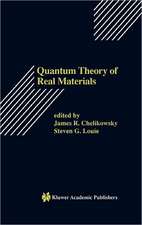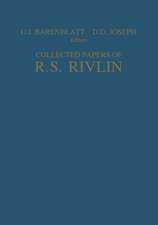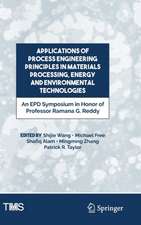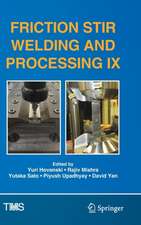Electronic Materials: A New Era in Materials Science: Springer Series in Solid-State Sciences, cartea 95
Editat de James R. Chelikowsky, Alfonso Franciosien Limba Engleză Paperback – 15 dec 2011
Din seria Springer Series in Solid-State Sciences
- 18%
 Preț: 1225.94 lei
Preț: 1225.94 lei - 18%
 Preț: 1017.62 lei
Preț: 1017.62 lei - 15%
 Preț: 532.05 lei
Preț: 532.05 lei - 18%
 Preț: 944.51 lei
Preț: 944.51 lei -
 Preț: 541.47 lei
Preț: 541.47 lei - 18%
 Preț: 956.96 lei
Preț: 956.96 lei -
 Preț: 385.84 lei
Preț: 385.84 lei - 18%
 Preț: 1827.48 lei
Preț: 1827.48 lei - 15%
 Preț: 661.02 lei
Preț: 661.02 lei -
 Preț: 389.88 lei
Preț: 389.88 lei - 15%
 Preț: 639.59 lei
Preț: 639.59 lei - 15%
 Preț: 635.15 lei
Preț: 635.15 lei - 18%
 Preț: 896.21 lei
Preț: 896.21 lei - 15%
 Preț: 647.92 lei
Preț: 647.92 lei - 15%
 Preț: 651.34 lei
Preț: 651.34 lei - 18%
 Preț: 890.23 lei
Preț: 890.23 lei - 15%
 Preț: 640.55 lei
Preț: 640.55 lei - 15%
 Preț: 649.54 lei
Preț: 649.54 lei - 15%
 Preț: 645.60 lei
Preț: 645.60 lei - 15%
 Preț: 644.30 lei
Preț: 644.30 lei - 15%
 Preț: 653.79 lei
Preț: 653.79 lei - 18%
 Preț: 956.69 lei
Preț: 956.69 lei - 15%
 Preț: 637.59 lei
Preț: 637.59 lei - 23%
 Preț: 1043.42 lei
Preț: 1043.42 lei - 15%
 Preț: 639.08 lei
Preț: 639.08 lei - 15%
 Preț: 648.24 lei
Preț: 648.24 lei - 15%
 Preț: 637.46 lei
Preț: 637.46 lei - 15%
 Preț: 640.06 lei
Preț: 640.06 lei -
 Preț: 391.40 lei
Preț: 391.40 lei -
 Preț: 390.84 lei
Preț: 390.84 lei - 15%
 Preț: 638.57 lei
Preț: 638.57 lei - 18%
 Preț: 1006.06 lei
Preț: 1006.06 lei - 18%
 Preț: 730.79 lei
Preț: 730.79 lei - 15%
 Preț: 640.37 lei
Preț: 640.37 lei - 15%
 Preț: 643.65 lei
Preț: 643.65 lei - 18%
 Preț: 1231.01 lei
Preț: 1231.01 lei - 18%
 Preț: 950.21 lei
Preț: 950.21 lei - 15%
 Preț: 642.68 lei
Preț: 642.68 lei - 15%
 Preț: 640.55 lei
Preț: 640.55 lei - 18%
 Preț: 1229.10 lei
Preț: 1229.10 lei
Preț: 391.61 lei
Nou
Puncte Express: 587
Preț estimativ în valută:
74.94€ • 80.13$ • 62.48£
74.94€ • 80.13$ • 62.48£
Carte tipărită la comandă
Livrare economică 18 aprilie-02 mai
Preluare comenzi: 021 569.72.76
Specificații
ISBN-13: 9783642843617
ISBN-10: 3642843611
Pagini: 356
Ilustrații: XIV, 341 p.
Dimensiuni: 155 x 235 x 19 mm
Greutate: 0.5 kg
Ediția:Softcover reprint of the original 1st ed. 1991
Editura: Springer Berlin, Heidelberg
Colecția Springer
Seria Springer Series in Solid-State Sciences
Locul publicării:Berlin, Heidelberg, Germany
ISBN-10: 3642843611
Pagini: 356
Ilustrații: XIV, 341 p.
Dimensiuni: 155 x 235 x 19 mm
Greutate: 0.5 kg
Ediția:Softcover reprint of the original 1st ed. 1991
Editura: Springer Berlin, Heidelberg
Colecția Springer
Seria Springer Series in Solid-State Sciences
Locul publicării:Berlin, Heidelberg, Germany
Public țintă
ResearchCuprins
1. Introduction.- References.- 2. The Simplest Ab Initio Theory of Electronic Structure.- 2.1 Tight-Binding Theory.- 2.2 Universal Parameters.- 2.3 A Diatomic Molecule, N2.- 2.4 A Simplification Using Hybrids.- 2.5 Cohesion of N2.- 2.6 Polarizability of N2.- 2.7 Tetrahedral Semiconductor Bonds.- 2.8 Semiconductor Energy Bands.- 2.9 Cohesion in Semiconductors.- 2.10 The Dielectric Properties.- 2.11 Ionic Crystals.- 2.12 Covalency in Ionic Compounds.- 2.13 Transition-Metal Compounds.- 2.14 Summary.- References.- 3. Theory of Electronic Excitations in Solids.- 3.1 Quasiparticle Theory of Electron Excitations.- 3.2 Band Gaps and Excitation Spectra of Bulk Crystals.- 3.3 Surfaces, Interfaces, Superlattices, and Clusters.- 3.4 Model Dielectric Matrix.- 3.5 Summary and Conclusions.- References.- 4. Determination of the Electronic Structure of Solids.- 4.1 Band Mapping with Photoemission and Inverse Photoemission.- 4.2 Understanding Semiconductors from First Principles.- 4.3 Magnetic Storage and Thin Film Magnetism.- 4.4 Optoelectronics and Excited State Spectroscopy.- 4.5 Spatial Resolution.- 4.6 Packaging, Polymers, and Core Levels.- 4.7 Summary.- References.- 5. Predicting the Properties of Solids, Clusters and Superconductors.- 5.1 Background.- 5.2 Surfaces and Interfaces.- 5.3 Total Energies and Structural Properties.- 5.4 Compressibilities and Empirical Theories.- 5.5 Metallic Clusters.- 5.6 Superconductivity.- 5.7 Conclusions.- References.- 6. High-Temperature Superconductivity: The Experimental Situation.- 6.1 Structural and Chemical Nature of the New Materials.- 6.2 The Superconducting State: Macroscopic Properties.- 6.3 Microscopic Superconducting Properties.- 6.4 Theoretical Considerations and Discussion.- References.- 7. Surface Structure and Bonding of Tetrahedrally Coordinated Compound Semiconductors.- 7.1 Key Concepts in Semiconductor Surface Chemistry.- 7.2 Zincblende (110) Surfaces.- 7.3 Wurtzite Cleavage Surfaces.- 7.4 Adsorption on Zincblende (110) Surfaces.- 7.5 Synopsis.- References.- 8. Formation and Properties of Metal-Semiconductor Interfaces.- 8.1 Experimental Techniques and Analysis.- 8.2 Interface Formation at 300 K.- 8.3 Low-Temperature Interface Formation.- 8.4 Surface Photovoltaic Effects.- 8.5 Interface Formations with Metal Ions.- 8.6 Interfaces Formed by Metal Cluster Deposition.- 8.7 Prospects and Future Developments.- References.- 9. Electronic States in Semiconductor Superlattices and Quantum Wells: An Overview.- 9.1 Envelope-Function Description of Electronic States.- 9.2 External Fields.- 9.3 Excitons in Quantum Wells.- References.- 10. Photonic and Electronic Devices Based on Artificially Structured Semiconductors.- 10.1 Resonant Tunneling Bipolar Transistors with a Double Barrier in the Base.- 10.2 Devices with Multiple Peak I-V Characteristics and Multiple-State RTBTs.- 10.3 Circuit Applications of Multiple-State RTBTs.- 10.4 Gated Quantum Well and Superlattice-Base Transistors.- 10.5 Quasi-Electric Fields in Graded-Gap Materials.- 10.6 Heterojunction Bipolar Transistors with Graded-Gap Layers.- 10.7 Multilayer Sawtooth Materials.- 10.8 AlGaAs Floating-Gate Memory Devices with Graded-Gap Injector.- References.- 11. Quantum Structural Diagrams.- 11.1 Interatomic Forces.- 11.2 Ionic Crystals.- 11.3 Covalent Crystals.- 11.4 Metallic Compounds and Alloys.- 11.5 Molecular Structure Diagrams.- 11.6 Deductive Calculations.- 11.7 Prospects.- References.- 12. Ion and Laser Beam Processing of Semiconductors: Phase Transitions in Silicon.- 12.1 Ion Implantation.- 12.2 Amorphization and Solid Phase Epitaxy.- 12.3Ion-Beam Induced Epitaxy, Diffusion and Segregation.- 12.4 Thermodynamic and Kinetic Properties of Amorphous Si.- 12.5 Liquid Phase Crystal Growth and Dopant Segregation.- 12.6 Melting of Amorphous Si: A First-Order Phase Transition.- 12.7 Conclusion: Undercooling and Explosive Crystallization.- 12.8 Update: The State of Amorphous Si.- References.




















